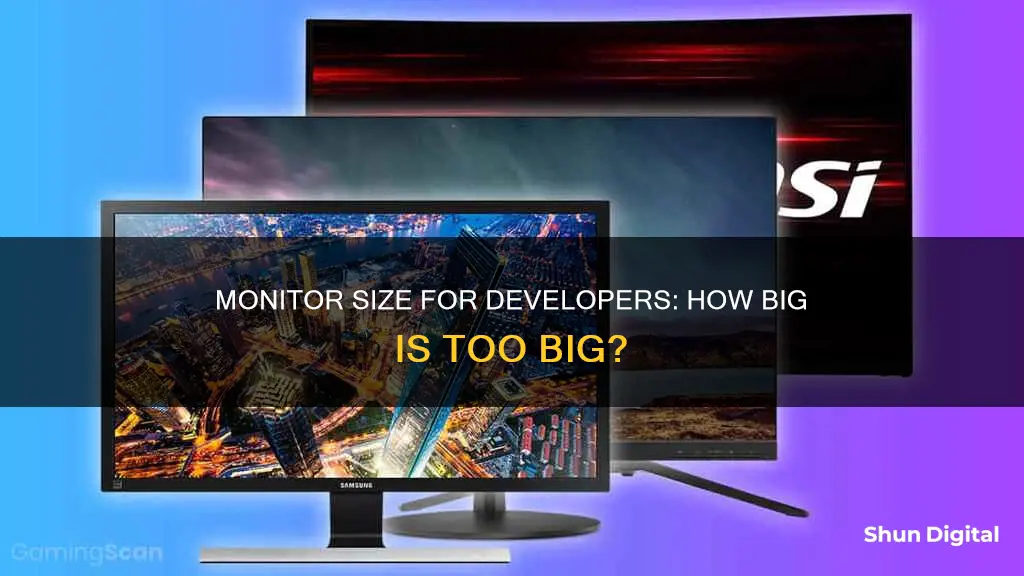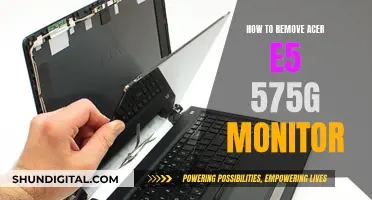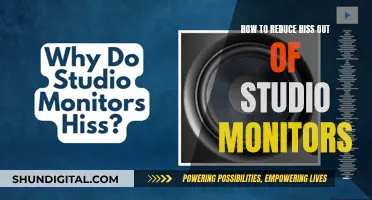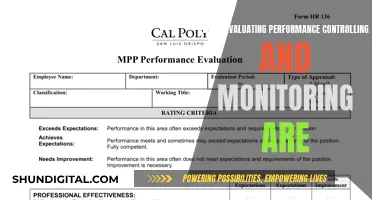
When it comes to monitors for developers, there are many factors to consider. The size of a monitor is a personal preference, but it's important to get something with a big screen so that you can see more lines of code at once. Resolution is also key, as a high resolution increases the pixel density and results in sharper text clarity, which is useful for coding.
The LG 32UL950-W 32″ monitor is a good option for a clear, immersive display, while the Dell U2723QE is a 27-inch, 4k monitor with a massive USB hub. The Dell U4025QW is another ultrawide option with a 5120x2160 resolution, resulting in fantastic text clarity.
For a budget option, the ViewSonic VP2458 monitor is a 24-inch screen with full HD resolution and wide viewing angles. If you're looking for something more advanced, the BenQ PD3220U is a 32-inch monitor with a 4K display and Pantone Validated and Calman-verified color accuracy.
Other features to consider include wide viewing angles, good ergonomics, high contrast ratios, and high brightness, depending on your work environment.
What You'll Learn

Screen resolution and size
When it comes to screen resolution and size, there are a few things to consider when choosing a monitor for programming. Firstly, a high-resolution monitor will provide better readability and make it easier to read and write code. The most common resolutions are 1080p, 1440p, and 4K. 4K monitors offer the sharpest visuals and can display four times the content on the screen at once, making them ideal for programmers. However, they are also the most expensive. If you're on a budget, a 1080p monitor is the minimum you should settle for.
When it comes to screen size, this is more of a personal preference. Smaller screens may be preferred due to desk space constraints, while larger screens can provide more space for multiple windows and applications. If you opt for a larger screen, such as 27 inches or more, consider a higher resolution to maintain crisp visuals.
It's worth noting that physical screen size does not determine how much content can fit on the screen. Instead, it is the resolution that matters. For example, a 25" 1080p monitor will not provide more screen real estate than a 22" 1080p monitor. To fit more content on the screen, you need to increase the resolution, not the physical size.
When choosing a monitor, it's also important to consider the pixels per inch (PPI). A higher PPI means a higher density of pixels, resulting in sharper text and images. For comfortable viewing and reading, it's important to find the right balance between screen size, resolution, and viewing distance.
Additionally, some programmers may prefer a dual monitor setup, allowing them to have one screen dedicated to coding and another for specifications, chat windows, or documentation. An alternative is an ultra-widescreen monitor, which provides a seamless working experience without bezels between windows.
China's Internet Surveillance: Monitoring Online Activities
You may want to see also

Dual monitor setup
A dual monitor setup can be highly beneficial for developers, offering increased productivity and efficiency. Here are some key advantages of using two monitors:
Split Screens for Coding and Research
With dual monitors, developers can dedicate one screen to their integrated development environment (IDE) and terminal, while using the other screen for documentation, online resources, and reference materials. This setup eliminates the need for constant alt-tabbing between windows, making it easier and faster to access relevant information.
Time Savings in Window Management
The additional screen real estate provided by a second monitor allows for better organization and management of multiple applications. Instead of juggling windows across a single screen, developers can snap programs to specific sections of their screens, saving time and improving workflow efficiency.
Enhanced Screen Sharing Capabilities
For developers who engage in pair programming, dual monitors can be a lifesaver. During remote collaboration, one screen can be dedicated to development work with a colleague, while the other screen remains available for personal use. This setup enables seamless sharing without compromising individual productivity.
Focus and Deep Work
Some may argue that dual monitors can be distracting, but proper utilization can enhance focus and facilitate deep work. By treating one screen as the primary development workspace and the other as a secondary reference tool, developers can maintain their attention on the main screen while having easy access to necessary resources.
Improved Ergonomics and Comfort
Dual monitors can also contribute to improved ergonomics and comfort for developers. By adjusting the positioning and orientation of the monitors, developers can reduce neck strain and eye fatigue associated with constantly shifting their gaze between windows on a single screen.
In conclusion, a dual monitor setup offers numerous advantages for developers, including improved efficiency, enhanced collaboration, better focus, and reduced physical strain. By utilizing the additional screen real estate and organizing their workflow effectively, developers can maximize their productivity and create a more comfortable working environment.
Monitoring App Bandwidth: A Comprehensive Guide to Track Usage
You may want to see also

Monitor stands
- Adjustability: Look for a monitor stand that offers a wide range of adjustments, including height, tilt, swivel, and pivot. This will allow you to find the most comfortable and ergonomic viewing position, reducing eye strain and improving your overall comfort during long coding sessions.
- Sturdiness: Ensure that the stand is sturdy and stable. A wobbly monitor can be distracting and may affect your productivity. Look for stands made of high-quality materials that can securely hold the weight of the monitor.
- VESA Compatibility: VESA compatibility is an important feature to look for in a monitor stand. VESA mounting refers to the standard mounting interface used by most monitors and allows you to attach the monitor to the stand or mount it on a wall. This provides flexibility in how you set up your workspace.
- Cable Management: A good monitor stand should also offer cable management solutions. Look for stands with built-in cable routing systems that help keep your cables organized and out of the way, contributing to a neat and clutter-free desk setup.
- Aesthetic Design: While not the most critical factor, the design of the monitor stand can also be considered. Choose a stand that complements the design of your monitor and your workspace aesthetic. Some stands offer a sleek and modern look, while others are more minimalist and discreet.
- Additional Features: Some monitor stands offer additional features such as built-in USB hubs or headphone docks. These can be convenient if you want to connect peripherals or charge your devices directly from the stand.
When choosing a monitor for programming, pay close attention to the included stand and its adjustability, sturdiness, and compatibility with VESA mounts. A good monitor stand can improve your viewing experience, provide ergonomic benefits, and contribute to a more organized and aesthetically pleasing workspace.
Resetting Your ASUS Monitor's Colors: A Step-by-Step Guide
You may want to see also

Refresh rate and response time
When it comes to monitors for developers, refresh rate and response time are crucial factors to consider.
The refresh rate refers to the number of times per second the display on a screen is refreshed and is measured in Hertz (Hz). A higher refresh rate means a smoother image, as it can display more frames per second. For example, a 144 Hz refresh rate will show 84 more pages per second than a standard 60 Hz rate, providing a more fluid viewing experience. Most monitors have a 60 Hz refresh rate, but some go higher, and higher is generally better. Gaming monitors, especially those used by competitive gamers, tend to have higher refresh rates, ranging from 120-144 Hz, with some reaching an astounding 240 Hz.
Response time, on the other hand, refers to the time it takes for a monitor's pixels to shift from one colour to another and is typically measured in milliseconds. Lower response times are preferable as they reduce issues like blurring or "ghosting". A typical LCD monitor will have a response time of under 10 milliseconds, with some as fast as 1 millisecond. For day-to-day tasks such as web browsing or word processing, response time is not a critical factor. However, for gamers, every millisecond counts, and a low response time between 1 and 5 milliseconds can provide a competitive edge.
When selecting a monitor, it is essential to consider both the refresh rate and response time together. A high refresh rate with a slow response time may result in a blurry image, negating the benefits of the higher refresh rate. Additionally, the type of panel used in the monitor can impact the response time and overall performance. TN (Twisted Nematic) panels are typically faster but offer a poorer colour range, while IPS (In-Plane Switching) panels provide more accurate colours but have higher response times. VA (Vertical Alignment) panels aim to strike a balance between response time and colour accuracy.
For developers, a monitor with a decent refresh rate and response time can enhance productivity. While a high refresh rate provides a smoother viewing experience, it is not always necessary to have the absolute latest technology. A balance between performance and cost should be considered. Additionally, other factors such as screen size, resolution, and ergonomics should also be taken into account when choosing a monitor for development work.
Troubleshooting an ASUS Monitor That Keeps Turning On
You may want to see also

Panel type
When it comes to choosing a monitor, one of the most important factors to consider is the panel type. The panel type refers to the technology used to produce the images displayed on the screen. While there are several types of panels available, the three most common ones are Twisted Nematic (TN), In-Plane Switching (IPS), and Vertical Alignment (VA). Each of these panel types has its own advantages and disadvantages in terms of colour accuracy, viewing angles, response time, and price.
TN panels were the earliest type of panels but are still widely used today. They tend to have the best response times and refresh rates, making them a popular choice for high-end gaming monitors. However, TN panels often have poor colour accuracy and washed-out-looking images. They also suffer from colour shifting issues when viewed from different angles.
IPS panels, on the other hand, are known for their excellent colour accuracy and wide viewing angles. They provide vibrant and consistent colours, making them a preferred choice for tasks that require precise colour representation, such as graphic design, photo editing, or video production. While IPS panels typically have slower response times and lower refresh rates compared to TN panels, they are still suitable for software development, movie watching, and casual gaming. It's worth noting that not all IPS panels are created equal, and some may have issues like "IPS glow" or "backlight bleeding".
VA panels offer a balance between TN and IPS technologies. They have good response times, colour accuracy, and viewing angles, but don't excel in any particular area. VA panels are often a jack-of-all-trades option, and their price and other features should be considered before making a purchase decision.
When choosing a monitor for programming or development work, it's important to prioritise colour accuracy and viewing angles. Therefore, IPS panels are usually the best choice for developers as they provide consistent and accurate colours, which is crucial for designing, coding, and editing tasks. While VA panels can also offer good colour accuracy, they may not match the performance of IPS panels in this regard. TN panels, with their limited colour accuracy and viewing angles, are generally not recommended for development work unless there are significant price or performance advantages.
In summary, the panel type of a monitor plays a crucial role in the overall performance and user experience. For programming and development work, IPS panels are typically the best option due to their excellent colour accuracy and wide viewing angles. However, VA panels can also be a good choice if they offer similar colour accuracy and viewing angles at a more attractive price point. TN panels, while offering superior response times and refresh rates, fall short in colour accuracy and are not usually recommended for development work.
Measuring LED Monitors: Screen Sizing Simplified
You may want to see also
Frequently asked questions
The ideal screen size depends on your personal preference and the space available on your desk. Larger screens, such as 27-inch or 32-inch monitors, can improve productivity by allowing you to view more code at once and work with multiple windows side by side. However, larger screens usually require higher resolutions to maintain sharp text and images.
Curved monitors offer an immersive viewing experience and can reduce eye strain, especially for those who spend long hours coding. However, they may not be ideal for UI/UX design work due to the distortion of straight lines. Ultimately, the choice between a flat or curved monitor depends on your specific needs and preferences.
A high resolution is important to ensure clear and sharp visuals. Look for monitors with Full HD (1920 x 1080), QHD (2560 x 1440), or 4K (3840 x 2160) resolution. 4K monitors provide the best experience, displaying four times the content of a 1080p monitor, but they are also more expensive.







